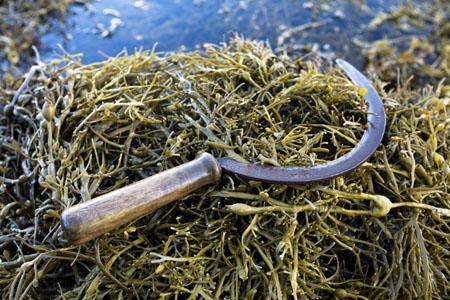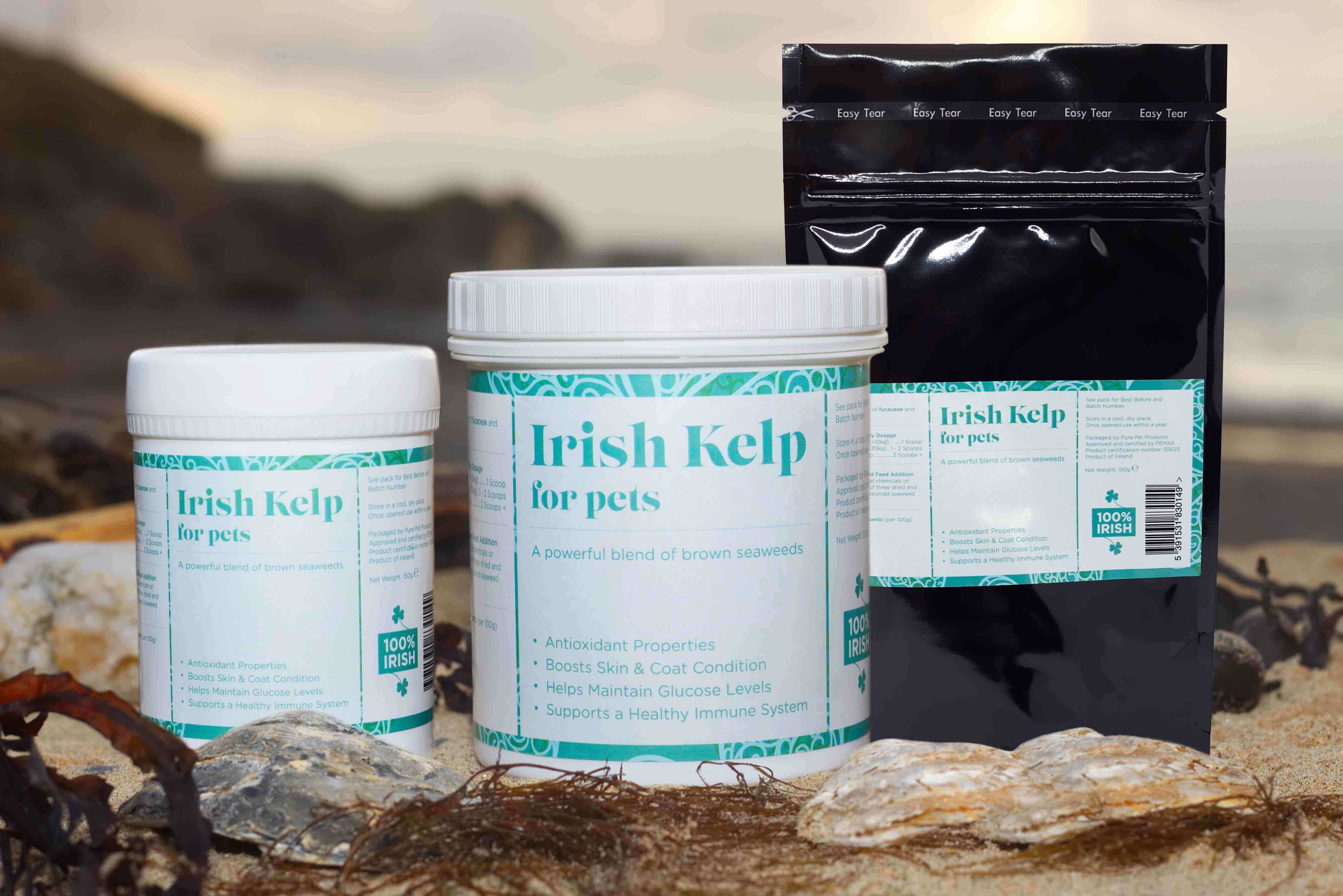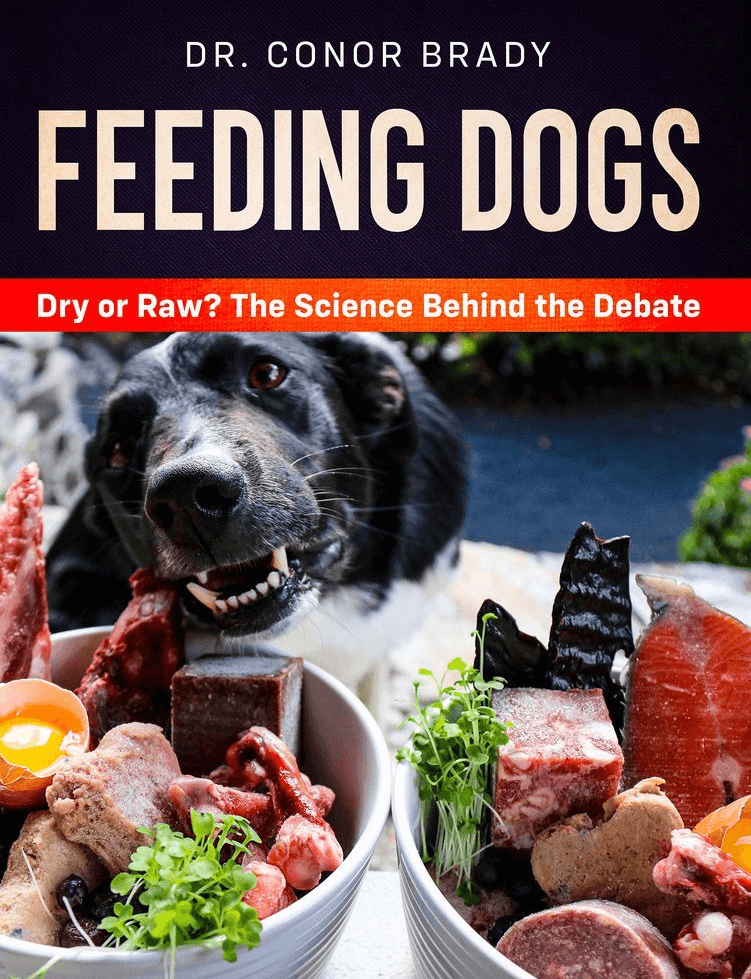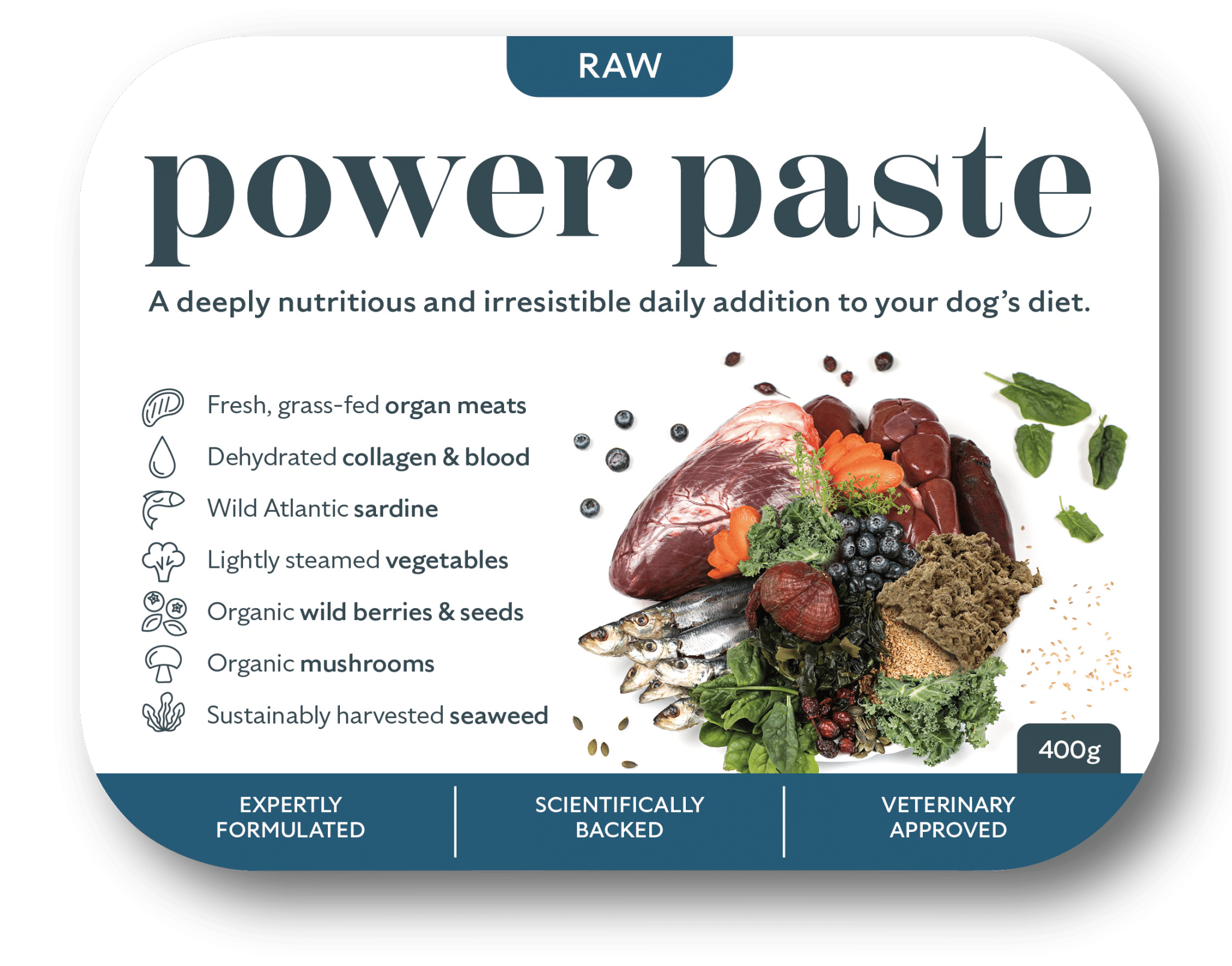There is Confusion Online About the use of Seaweed in Dogs, Largely Over Iodine Concerns, Here’s the Low Down…
We’re clearly huge seaweed fans here in Dogs First. It all began when my friend and I bumped into a scientist with 30 years experience in the seaweed field. To say he was passionate about these plants is an understatement. The truth is there are more seaweeds in the ocean (at least 10,000) than herbs on the planet and, what’s more, it seems each of these little plants are positively packed with goodies, many of which are entirely unique to plants that live under our waves. One of these goodies is iodine, something your pet absolutely needs but not all seaweeds are high in iodine and, moreover, they offer such a range of unbelievable, clinically proven benefits, that to throw these babies out with the seawater would be a catastrophic mistake. Here’s what we know about using seaweed in dogs.

Why Seaweed is Recommended for Both Dry and Raw Fed Dogs…
Iodine is vital in the diet, to them and us. A lack of iodine can cause all sorts of problems in dogs, including;
- low energy or lethargy
- unexplainable weight gain (“just can’t seem to get the weight off him”)
- poor coat hair loss
- cold intolerance
- autoimmune issues involving the thyroid
- heart and lung problems
- extreme nervousness
- restlessness and general behavioural issues
Sadly, until recently, not every pet food manufacturer was including it in their mixes, as it wasn’t (and still isn’t) a required nutrient in pet food, for reasons best known to themselves. In fact, 20 years ago folk started pointed at the lack of iodine in pet food as the cause of the increasing amount of hypothyroidism in dogs (where the thyroid underproduces thyroid hormones). that was being witnessed in the Western World at that time. Once this was decided, pet food manufacturer started including it in their mixes. But like all things pet food, you couldn’t be guaranteed anyone a) was actually doing it or b) how careful they were when doing it.
In 2002, studies showed that in 2002 cat food varied wildly as to how much iodine they contained with 25% of them containing none at all. That study found that cats eating such diets exhibited abnormal thyroxine (thyroid hormone) levels and benefitted from a normal inclusion of iodine in their diet. Hodgkinson et al. (2004) analysed 33 brands of dry food and found 12 had too little iodine. In fact, studies since, again in cats, have reported that cats consuming commercial foods which were relatively deficient in iodine were more than 4 times as likely to develop hyperthyroidism compared with cats that ate iodine-supplemented foods (Edinboro et al. 2004 and 2010).
Too little iodine in the diet will cause these pets all sorts of issues as a result of a mis-firing thyroid. Unsurprisingly, numerous studies indicate that an iodine deficiency can result in thyroid issues, at least in cats,
…a recent case-control study reported that cats consuming commercial foods which were relatively deficient in iodine were more than 4 times as likely to develop hyperthyroidism compared with cats that ate iodine-supplemented foods
Veterinary Endocrinology, Does Iodine Deficiency Cause Thyroid Disease in Cats?
While we can’t account for the fact that many “complete” dry foods may be excessive in it (just another reason not to feed such a ridiculous product and instead opt for a species appropriate, raw dog food diet) it’s clear adding a little seaweed to their dry diets at this point would prevent against this issue. That said, raw feeders are not off the hook either. Iodine is mostly concentrated in the thyroid of animals. However, thyroid by and large is not included in raw dog food. In the past, the use of beef thyroid in some pet foods and treats has harmed pets (a result of too much thyroxine). However the use of thyroid in pet food is not the norm for this very reason. Further, rarely is the thyroid of poultry included as it’s in under the carcass and often removed in the processing of the bird.
The second highest concentration of iodine in the body (especially for females) is in the ovaries and yet these too are excluded from the diet of most dogs. Other sources are salivary glands and brain. All parts most raw-fed dogs never see. Hence, I’m confident it will be found that raw dog food vary greatly in their iodine contents and dogs fed upon them might benefit from seaweed inclusion.
So, normally, both dry and raw fed dogs benefit from the addition of seaweed to their diet. But we don’t just use seaweed in dogs because of its iodine content. It does much more than that.
There is a Huge Range of Benefits From Using Seaweed in Dogs That go Beyond Iodine Content…
There are so many benefits to using seaweed in dogs. At a top level, with our own soils eroding and intensively farmed meats plummeting in nutritional value, at a top level seaweeds, each of them packed full of vitamins and minerals, offer us a simple way of adding a pinch of serious and vital nutrition to each meal. Moreover, other superfoods, such as spirulina, are now being massed produced in Asia, often in open-to-the-air pools, which leaves them prone to contamination. Heavy-metal adulteration of these products is now rife. This is before we talk about the fact we are running out of agricultural land up here on the surface and when some seaweeds grow up to a foot in length per day, plants beneath the surface need no chemicals, no watering, no help of any kind. It’s why seaweeds such as the rapidly growing kelp, is an increasingly popular food supplement for people and pets alike.
But it goes deeper than simply nutrition. For example, there are a large amount of very high-quality clinical trials that support the use of seaweed in fighting cancer of various forms. The article, from which the table below was taken, highlights they have been found to be antiviral, antibacterial, antimutagenic, anti-HIV and can even delay the ageing process!! They are likely the future to help us kerb antibiotic use, at least in agriculture.

Working with the seaweed scientist, we have uncovered a range of uses for seaweeds. We have developed a range of air dried (you can’t use heat), sustainably harvested, seaweed-based products for dogs based on the aforementioned studies that our testimonials are proving are highly effective. From reducing weepy eyes in dogs and boosting gut health to a stool former for constipated or dogs with diarrhoea even a blend of four seaweeds that the studies above have shown to be anti-cancerous in various forms, we are only touching on what these plants can offer. In the pipeline, we have two more exciting products coming this year, once we prove their efficacy (keep an eye on our Facebook page for updates here).

Thus, the thinking since has been it’s good to use seaweed in dogs. The problem occurs when you are not dealing with a normal dog but one that has malfunctioning thyroid.
So What About the Risks of Too Much Iodine in Dogs With Thyroid Issues
Of course, too much of anything is not good news either. Now some pet owners might be faced with the possibility that they are adding in too much iodine to their pet’s life, and that can result in the over-production of some thyroid hormones, also causing issues, certainly in dogs with pre-existing thyroid issues. Dr. Jean Dodds is leading this charge, in that her recent article on iodine use in dogs highlighting her concern in dogs with thyroid issues is doing the rounds (good) but unfortunately spooking all owners, be they of healthy dogs or not (not so good, but common in this rapidly evolving and expanding field of science).
Jean Dodds knows more about canine blood work than practically anyone on the planet. So when Jean speaks on something like hypothyroidism, we listen, or we read (her book on The Canine Thyroid Epidemic, find on Amazon, is excellent). Jean highlights a number of interesting causes for the growing in issue in pets, most importantly over-vaccination, showing beagles developed antibodies against canine thyroglobulin (a protein present in the thyroid gland) after vaccination with a rabies vaccine.
In the case of iodine, Jean draws our attention to the fact that while many recommend seaweed for dogs with hypothyroidism (including me, I have to admit, up until I read her book at least, but never for dogs with hyperthyroidism, which is much rarer and usually the result of thyroid damage). It seems that most hypothyroidism in dogs is a result of inherited auto-immune issue, not unlike Hashimoto’s Lymphocytic Thyroiditis, in humans and thus not an iodine deficiency, so seaweed would be less useful in most hypothyroid dogs. More importantly, Jeans points out, too much iodine for these dogs could cause problems, possibly causing the thyroid to over-produce some of the hormones (T3 and T4) while not producing the others (T1 and T2). While unreferenced, this theory makes instant sense to me. Morever, as she is the absolute boss, and as it is a field to which I am completely unfamiliar, I’m not about to go Googling to try and prove her wrong.
Thus the advice is now – if your dog has or is suspected to have any thyroid issue whatsoever, I definitely wouldn’t be using true kelp (Laminaria) in their diet
However, at this point, we must highlight that this concern is for dogs with a thyroid issue, not your normal, everyday healthy dogs whom seaweed still very much remains on the menu. Crucially so, in many cases. And then, not all seaweeds are very high in iodine…
Not All Seaweeds are Very High in Iodine…

Let’s take a deeper look at the figures. Of all seaweeds, true kelp (Laminaria, the stuff that grows in big underwater forests) is the most popularly used in dogs. It has a range of benefits already highlighted above but also a lot of old wives tales connected to it that I have struggled to verify including it makes the nose of the dog darker in colour hence breeders use it for showing their dogs. Maybe, maybe not.
True kelp is also the highest in iodine by a considerable degree. Kelp contains, very approximately, 1.356 mg of Iodine per gram of seaweed. Compare this to a seaweed we like to use a lot in our blends due to its functionality called Dulce (Palmaria Palmata) contains only 0.072 mg/g of Iodine. Ascophyllum (the stuff with the air bladders you can pop with your fingers on the seashore around Ireland and the UK), another popular seaweed in dogs, varies wildly seasonally but let’s say is around 0.4-0.7 mg of Iodine per gram. So there’s huge variation out there.
According to the AAFCO minimum nutritional guidelines, dogs require 1mg of iodine per kilo of dry food. However, we are talking about fresh food here (with water). You have to eat around twice as much fresh food as dry, say, so that equates to 0.5mg of “iodine” per kg of raw.
I use those sarky inverted commas as the AAFCO nutrient profile suffers from major issues. In this instance, they use iodide instead of naturally occurring iodine (if you follow any of my stuff you’ll see it’s the same with zinc, vitamin E etc). They use industrially-produced compounds that are poorly absorbed meaning you have to use a lot more of them. So, if AAFCO say 1mg is necessary, often a lot less of the naturally occurring (chelated, bound to a carbon molecule) stuff is fine (more on all that here). for now, check out how flaky their basis is for their iodine figures are here – they’re based on estimates from horses and swine fed processed food. Useless.
If there is 1.3mg of natural iodine in dried Laminaria and dogs need 0.5mg of “iodine” per 1kg of raw at a minimum then this equates to 1g of dried Laminaria per 2kg of raw, if minimum is the concern.
However, I think you should use much more based on the evidence that animals we have studied (humans and horses) can and do regularly eat a LOT more iodine than their RDA suggests when on good diets with review studies finding no problems with some very high levels of consumption (e.g. many Japanese, who include seaweed in 28% of their meals, are often found to consume between 10-20 times their RDA of iodine, to no ill effect).
Is a couple of times their RDA of iodine too much for the average dog? For a healthy dog? Likely not. Historically, pet foods have been found to contain up to ten times their RDA of iodine, though we don’t know what effect this was having on them. However, if your dog was suffering from thyroid issues, then for sure, possibly, especially considering what Jean is saying above.
While true kelp may be off the menu for thyroid-at-risk dogs, as we said showed above, Laminaria is but one seaweed and as it happens to be the highest in iodine, maybe now’s the time to check out all the other seaweeds that are available to you. We only use Laminaria in one our blends for this very reason (Kelp in Dogs), as so many people are looking for it. All our other seaweed products are made using seaweeds that contain substantially less iodine but have all the other benefits. Moreover, we use only seaweeds that have been sustainably harvested from the Irish coast and, most importantly, we do not use heat in the drying process, crucial to preserving the fragile polysaccharides inside which have all the good effects!
Seaweed in Dogs, in Conclusion.
Are you confused yet? Here’s what we have sort-of-learned in bullet point form:
- In healthy dry fed pets, I recommend using a little seaweed in dogs and cats because of the range of benefits seaweed offers beyond simply iodine content. If unsure, simply use a half dose or avoid true kelp (Laminaria) which is higher in iodine. Know that kelp is but one of 10,000 species, so you have lots to choose from.
- In healthy raw fed dogs, definitely recommend but if concerned take the cautionary steps above.
- In pets with any sort of thyroid issues, probably best not until more is known.













